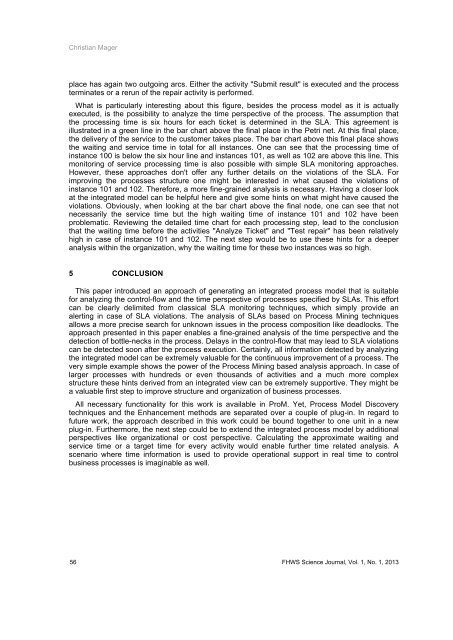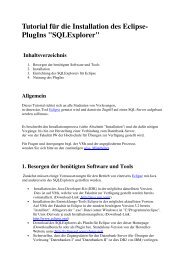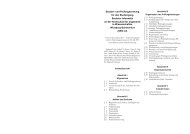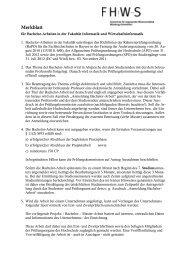FHWS Science Journal - Fakultät Informatik und Wirtschaftsinformatik
FHWS Science Journal - Fakultät Informatik und Wirtschaftsinformatik
FHWS Science Journal - Fakultät Informatik und Wirtschaftsinformatik
You also want an ePaper? Increase the reach of your titles
YUMPU automatically turns print PDFs into web optimized ePapers that Google loves.
Christian Mager<br />
place has again two outgoing arcs. Either the activity "Submit result" is executed and the process<br />
terminates or a rerun of the repair activity is performed.<br />
What is particularly interesting about this figure, besides the process model as it is actually<br />
executed, is the possibility to analyze the time perspective of the process. The assumption that<br />
the processing time is six hours for each ticket is determined in the SLA. This agreement is<br />
illustrated in a green line in the bar chart above the final place in the Petri net. At this final place,<br />
the delivery of the service to the customer takes place. The bar chart above this final place shows<br />
the waiting and service time in total for all instances. One can see that the processing time of<br />
instance 100 is below the six hour line and instances 101, as well as 102 are above this line. This<br />
monitoring of service processing time is also possible with simple SLA monitoring approaches.<br />
However, these approaches don't offer any further details on the violations of the SLA. For<br />
improving the processes structure one might be interested in what caused the violations of<br />
instance 101 and 102. Therefore, a more fine-grained analysis is necessary. Having a closer look<br />
at the integrated model can be helpful here and give some hints on what might have caused the<br />
violations. Obviously, when looking at the bar chart above the final node, one can see that not<br />
necessarily the service time but the high waiting time of instance 101 and 102 have been<br />
problematic. Reviewing the detailed time chart for each processing step, lead to the conclusion<br />
that the waiting time before the activities "Analyze Ticket" and "Test repair" has been relatively<br />
high in case of instance 101 and 102. The next step would be to use these hints for a deeper<br />
analysis within the organization, why the waiting time for these two instances was so high.<br />
5 CONCLUSION<br />
This paper introduced an approach of generating an integrated process model that is suitable<br />
for analyzing the control-flow and the time perspective of processes specified by SLAs. This effort<br />
can be clearly delimited from classical SLA monitoring techniques, which simply provide an<br />
alerting in case of SLA violations. The analysis of SLAs based on Process Mining techniques<br />
allows a more precise search for unknown issues in the process composition like deadlocks. The<br />
approach presented in this paper enables a fine-grained analysis of the time perspective and the<br />
detection of bottle-necks in the process. Delays in the control-flow that may lead to SLA violations<br />
can be detected soon after the process execution. Certainly, all information detected by analyzing<br />
the integrated model can be extremely valuable for the continuous improvement of a process. The<br />
very simple example shows the power of the Process Mining based analysis approach. In case of<br />
larger processes with h<strong>und</strong>reds or even thousands of activities and a much more complex<br />
structure these hints derived from an integrated view can be extremely supportive. They might be<br />
a valuable first step to improve structure and organization of business processes.<br />
All necessary functionality for this work is available in ProM. Yet, Process Model Discovery<br />
techniques and the Enhancement methods are separated over a couple of plug-in. In regard to<br />
future work, the approach described in this work could be bo<strong>und</strong> together to one unit in a new<br />
plug-in. Furthermore, the next step could be to extend the integrated process model by additional<br />
perspectives like organizational or cost perspective. Calculating the approximate waiting and<br />
service time or a target time for every activity would enable further time related analysis. A<br />
scenario where time information is used to provide operational support in real time to control<br />
business processes is imaginable as well.<br />
56 <strong>FHWS</strong> <strong>Science</strong> <strong>Journal</strong>, Vol. 1, No. 1, 2013








